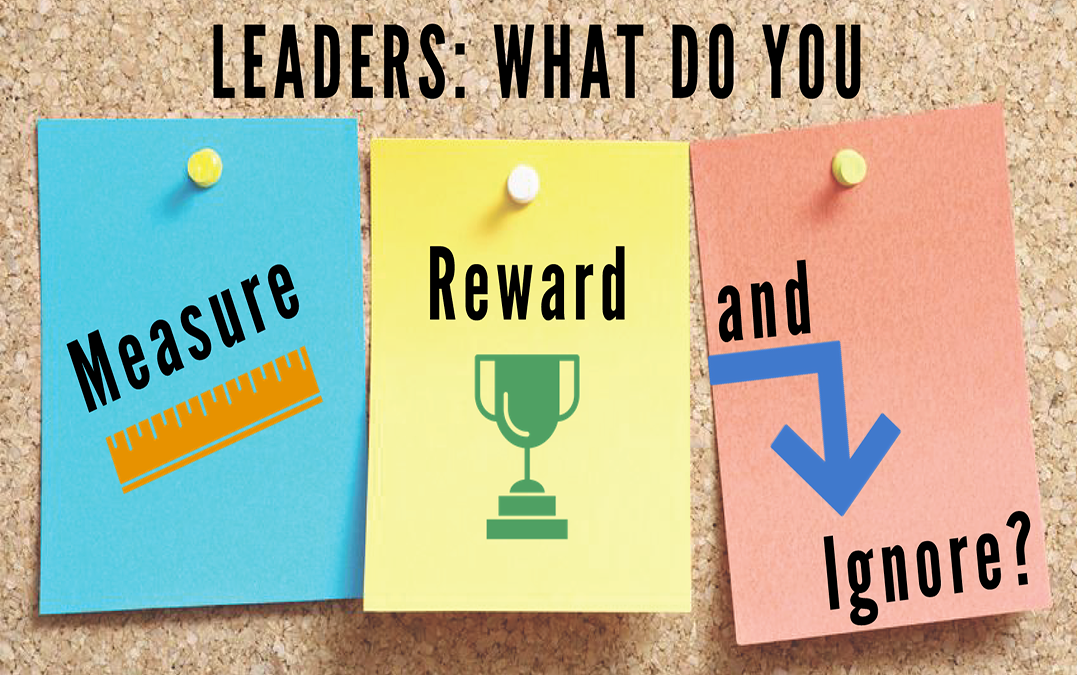
Leaders: What do you Measure, Reward, and Ignore?
Culture. What does that word actually mean?
Though many have tried, no one has ever landed on a fixed, universal definition for organizational culture. The subject has been vigorously debated from the pages of the Harvard Business Review to the halls of MIT Sloan. What is not debated is that culture is part of the DNA of every organization. Whether your organizational culture is empowering or toxic depends greatly on two factors: shared experience and modeled leadership.
Consider this. When new employees join your organization, they step in on Day 1 with a set of preconceived beliefs based on past experience. They may believe that markets are finite and there is only so much business to go around. They may believe that success is a win/lose proposition. Some have been taught that ethics and morals can be bent. Others have relied on the strict dictates of policies and procedures. That makes up the experience half of the equation.
The other half comes directly from modeled leadership. If the leaders of the organization are fixated on business development, channel expansion, and market domination, they are not likely spending any time intentionally trying to shape the culture. Unintentionally, however, they are sending very clear signals about what is important to them. They are the cultural architects of your organization and contribute three critical elements to the culture equation:
1. What is measured.
Let’s face it. Culture can be hard to measure. Senior executives tend to shy away from anything with a fuzzy ROI. Yet, whether you measure it or not, your culture is showing up in your bottom line. Skillfully managed cultures can be a performance multiplier. Recent research by the Great Place to Work© Institute found that companies that actively invest in workplace culture yield nearly 2x the return over their competitors. They also typically report 65% less voluntary turnover, saving an average of $3,500 per employee in recruiting and training costs. If culture isn’t part of your KPI mix, you’re sending the signal that it’s unimportant.
2. What is rewarded.
A recent study by O.C. Tanner found that employees report being recognized for their work as their most important motivator, over 20 times more than salary. Employees study what behaviors and achievements get rewarded, and naturally modify their work accordingly. Leaders who understand this connection create recognition programs that go beyond passing out paychecks. WD-40 CEO Garry Ridge proudly hosts the company’s annual People Choice Awards. Each year, heartfelt speeches are given by winners of coveted awards like “Best Mentor Coach” and “Best Team Player.” Leaders like Ridge know that coin-operated employees have no passion.
3. What is ignored.
Leaders are bombarded with data, hold back-to-back meetings, and field urgent requests on a daily basis. When we need to respond to fast-moving competitive situations, it is tempting to tap only our direct reports for feedback. In his Harvard Business Review article “The Focused Leader,” New York Times bestselling author Daniel Goleman warns that this temptation is dangerous. He recommends that leaders practice expanding their focus of awareness. “A failure to focus on others leaves you clueless, and a failure to focus outward may leave you blindsided,” Goleman writes. What’s worse, leaders who ignore input from those outside their immediate circle are signaling to the rest of the organization that their input is irrelevant.
Leaders are the cultural architects of your organization. The key metrics they pay attention to, the contributions they reward, and range of their awareness directly impact both your organizational culture and your bottom line.
Question: What do you measure, reward and ignore? How is that impacting your organizational culture?
Driven by the premise that excellence is the result of aligning people, purpose and performance, Center for Executive Excellence facilitates training in leading self, leading teams and leading organizations. To learn more, subscribe to receive CEE News!
